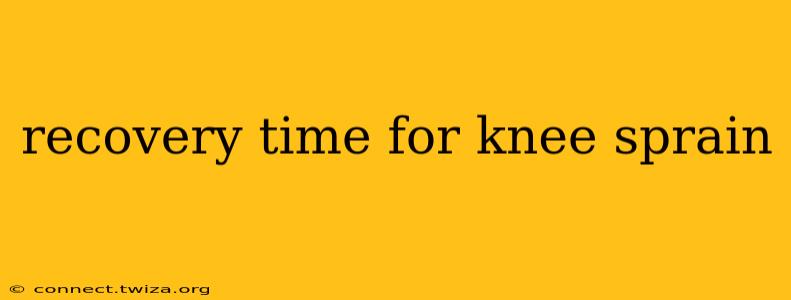A knee sprain occurs when the ligaments supporting your knee joint are stretched or torn. The recovery time for a knee sprain varies significantly depending on the severity of the injury. Understanding the different grades of sprains and the factors influencing recovery is crucial for effective treatment and a speedy return to normal activities. This guide will explore the recovery process, common questions, and tips for optimal healing.
What are the different grades of knee sprains?
Knee sprains are classified into three grades based on the extent of ligament damage:
- Grade 1 (Mild): Ligaments are stretched, but not torn. There's minimal instability, and swelling is usually mild.
- Grade 2 (Moderate): Ligaments are partially torn, resulting in moderate instability and swelling. Pain is more significant, and there may be some joint laxity (looseness).
- Grade 3 (Severe): Ligaments are completely torn, leading to significant instability, severe pain, and substantial swelling. The knee may feel unstable or give way.
How long does it take for a knee sprain to heal?
The recovery time for a knee sprain depends heavily on the severity of the injury:
- Grade 1: Typically heals within 1-3 weeks with rest, ice, compression, and elevation (RICE).
- Grade 2: Recovery takes 4-8 weeks, often requiring physical therapy to restore stability and strength.
- Grade 3: May require several months to heal completely, potentially involving surgery and extensive rehabilitation.
It's crucial to remember that these are estimates. Individual recovery times can vary based on several factors discussed below.
What factors affect knee sprain recovery time?
Several factors can influence how quickly a knee sprain heals:
- Severity of the sprain: As mentioned above, more severe sprains take longer to heal.
- Age: Younger individuals generally recover faster than older adults.
- Overall health: Underlying health conditions can impact healing time.
- Adherence to treatment: Following medical advice and participating in physical therapy is essential for optimal recovery.
- Proper rehabilitation: Consistent and diligent physical therapy exercises accelerate healing and prevent future injuries.
What are the symptoms of a knee sprain?
Recognizing the symptoms of a knee sprain is crucial for prompt treatment. Common symptoms include:
- Pain: Ranges from mild to severe, depending on the severity of the sprain.
- Swelling: Develops quickly after the injury.
- Bruising: May appear hours or days after the injury.
- Instability: The knee may feel unstable or give way.
- Stiffness: The knee joint may feel stiff and difficult to move.
- Limited range of motion: Difficulty bending or straightening the knee.
What is the treatment for a knee sprain?
Treatment for a knee sprain focuses on reducing pain and swelling, stabilizing the joint, and restoring function. Treatment options include:
- RICE: Rest, Ice, Compression, and Elevation.
- Pain relievers: Over-the-counter medications like ibuprofen or acetaminophen can help manage pain and inflammation.
- Physical therapy: Essential for restoring strength, stability, and range of motion.
- Bracing or support: May be used to stabilize the knee joint.
- Surgery: Reserved for severe grade 3 sprains that don't respond to conservative treatment.
How can I prevent future knee sprains?
Preventing future knee sprains involves strengthening the muscles surrounding the knee and improving overall balance and coordination. Consider these preventative measures:
- Regular exercise: Focus on strengthening exercises for the quadriceps, hamstrings, and calf muscles.
- Proper warm-up before activity: Prepare your muscles for exercise.
- Stretching: Improve flexibility and reduce the risk of injury.
- Appropriate footwear: Wear supportive shoes suitable for the activity.
- Maintain a healthy weight: Excess weight puts extra stress on your joints.
Can I exercise with a knee sprain?
Gentle exercise may be beneficial during the later stages of recovery. However, it's crucial to follow your physical therapist's guidance. Avoid activities that put stress on the injured knee until it's fully healed.
When should I see a doctor for a knee sprain?
Seek medical attention immediately if you experience:
- Severe pain.
- Significant swelling.
- Inability to bear weight on your leg.
- Deformity of the knee.
- Persistent instability.
This information is for general knowledge and does not constitute medical advice. Always consult with a healthcare professional for diagnosis and treatment of any medical condition. They can accurately assess your specific situation and recommend the most appropriate course of action.
